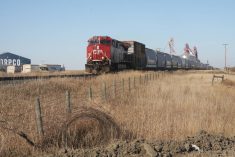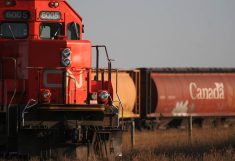SASKATOON – It’s an idea that has been around since 1977, but its time may finally have come.
A report commissioned by the National Farmers Union has recommended that a Prairie Rail Authority be set up as a way to protect farmers’ interest in the new deregulated world of grain transportation.
The locally run authority would manage branch lines and grain hopper cars and allocate grain cars among shippers.
The PRA was first recommended by the Hall Commission nearly 20 years ago, but Ottawa-based consultant Darrell Richards said that doesn’t mean it’s obsolete.
Read Also

Manitoba beekeepers battle for survival
Honeybee colony losses have hit 43 per cent, making 2025 the latest in a string of poor bee survival years for Manitoba’s honey producers
“The recommendation … is still valid and would bring prairie control to the grain system,” he said in the 49-page report released by the NFU last week.
Farmers union president Nettie Wiebe told reporters that while the organization isn’t yet ready to endorse the proposal, it will be discussing the report and its recommendations with members in coming weeks.
“I think that this idea has some potential,” she said. It returns some control to the region most affected, allows communities some input into decisions about the future of the system and retains for taxpayers the $900 million they have invested in branch line upgrading, she said.
The NFU commissioned the report by Transport Concepts to sort out implications of the continuing deregulation of the rail system and help farmers identify ways to deal with the situation.
Wiebe said farmers are “completely beholden” to the rail transportation system to move their product to market.
The NFU president added it’s “shocking and discomforting” that the federal government has done so little planning in terms of what the rail system will look like in a few years.
While Ottawa seems to believe the “invisible hand” of competition will take care of things, that doesn’t apply in Western Canada, where there is no real competition between the two national railways.
In his report, Richards said the end of the Western Grain Transportation Act has set in motion a process that could result in the demise of a Canadian-based transportation and grain marketing system.
“If the pace of mergers in the U.S. continues at its present rate, there would be only two or three major North American railroads within five years, and they will focus as much north-south as east-west,” he said. “In a continental, deregulated market, there will be little room or need for a transcontinental Canadian system.”
There will be little local control, he said, whether it’s inland terminal owners depending on multinational grain companies for access to overseas markets or short line railways depending on one of the few North American railways giants for cars and revenue sharing.
Put railways on contract
A Prairie Rail Authority would lease branch lines (not main lines) from the railways at an annual rate of $1 each. It would contract with CN and CP for maintenance and train operation and would make all future investment and abandonment decisions, with the participation of diverse prairie interests.
By taking over ownership of the federal government’s fleet of 13,000 hopper cars and handling all car allocation, the authority could provide equitable access to the rail network for producers of all sizes from all regions, said Richards.














